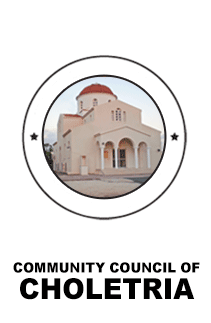We call it Voufa, according to Cyprus tradition or Loom, as it is called in Greece. Let’s see what this instrument is, how it works, and what it offers. In the Holetria village we will meet this useful until today tool. It is the glory and pride if you want, of the weaver, wife, daughter, who live in Holetria today.
The main parts of the voufa are:
‘Stilli’ (pillars), that as it was referred, are four pillars, fixed on the ground, in the form of a parallelogram.
The ‘antin’, a cylindrical piece of wood in which the weaving is wrapped.
The ‘pisantin’, is also a cylindrical piece of wood, from which the warp is unfolded. In the old types of voufa, the pisantin was useful only to keep the threads strained, that were unfolded by the front part of voufas and passed over it, fixed by katsin, a horizontal cylindrical piece of wood, fixed in the roof of the house.
The Htenin, through which the threads pass. It moves back and forth and it is fixed in two
Petals,are vertically placed boards, fixed on the verkan (stick), a piece of wood, which are placed horizontally between the (pillars)’stillon’.
The ptidkia, which are two, moves up and down the threads of the warp.
The mitarka, which are vertically, placed threads, behind the ‘Hteni’, through which the threads of the warp pass .The Mitarka are retained in the desirable dimensions, with mitoverkes. Mitoverkes and mitarka go up and down with the help of ‘patidkion ‘(tappets).
Types of weavers: Generally in the villages of Cyprus, there are various types of weavers, which were famous, well-known and coveted, mainly at the medieval years. In the voufa it was possible for woolly, cottons, linens, silk, clothes even rags to be weaved, and that produced the famous peftzia (koureloudes) that means carpets and rugs.
The width of the weaver that is woven depends or even regulated by the size of the xteni (comb). The length is not determined, because the weaver can weave as long as she wants, and to cut the threads of the warp in the desirable length. Still the type of the xteni (comb), can also determine the type of the weaving of the weave, which according to the thickness and the density of the comb’s teeth (xteni), a denser, thinner, thicker or even thinner weaving is achieved. And because of that there are various types of xtenia (combs).
The weavings were known for their beauty and quality from antiquity; therefore, the wool and the flax were basically used for weave. In the Byzantine years cotton and silk were added. Then the marvellous gold weaved and silk products of the Cypriot voufas were well known. At the medieval years 9 types of Cypriot weavers were coveted in Europe, as types of luxury.
The products of voufas were useful for several manufactures. For male and feminine costumes, sheets, carpets, curtains, tablecloths, mosquito nets, bed covers, disatsia, and a lots of others. Depending on the type and the use, they were figured with drawings at the weave, with stuffers, with beads, etc
In old times , lots of houses, in the cities and in the villages of Cyprus, were provided with voufa, in which the women made their dowry, satisfied all the needs of their family in clothing and simultaneously made products for marketing, that were coveted.
|
